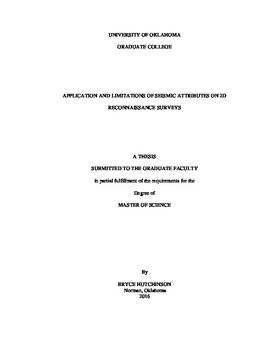| dc.description.abstract | Reconnaissance surveys of 2D seismic data are acquired before most 3D seismic
surveys to define the area of interest and regional trends. While seismic attributes are
routinely applied to 3D data, they are less commonly applied to 2D data. Today’s low
commodity prices call for the utilization of all available data. To quantify the value of 2D
attribute analysis I use attributes computed from a 3D survey covering the same area as
the baseline or ideal result. Using a 2D seismic survey overlying a 3D volume offshore
New Zealand in the Taranaki Basin, picked key horizons on 2D and 3D data, which were
in turn used to create surfaces and isochrons. Candidate attributes included RMS
amplitude, instantaneous frequency, instantaneous phase, similarity, curvature, and
spectral components.
The Taranaki Basin is a Cretaceous-aged failed rift basin with a complex
structural history. A poststack data conditioning workflow is constructed for 2D and 3D
to suppress crosscutting migration artifacts, and sharpen discontinuity features of the
structurally complicated environment. I used concepts of structural geology to validate
these discontinuity features as faults rather than organized artifacts. Structure-oriented
filtering deteriorates on 2D lines where out-of-the plane reflectors overprint features of
interest.
I also noted an underreported observation that edge-preserving structure-oriented
filtering can introduce frequencies that fall beyond the limits of the recorded seismic data.
On 2D vertical seismic lines, in the dip direction single trace attributes such as
spectral components, RMS amplitude and instantaneous attributes provide images
comparable to those computed from 3D. Geometric attributes computed from 2D dip lines
xx
render useful images of apparent dip and apparent (or Euler) curvature while similarity
maps the apparent dip of faults and channel edges.
Generating useful attribute maps from 2D data is more problematic, with major
limitations of both software flexibility and the author skill. While I can generate good
quality time structure, isochron, and horizon curvature maps from 2D data, I believe that
effective interpolation of shorter wavelength anomalies as mapped by RMS amplitude
and spectral components requires Kriging guided by a variogram constructed from the
time-structure maps. | en_US |
